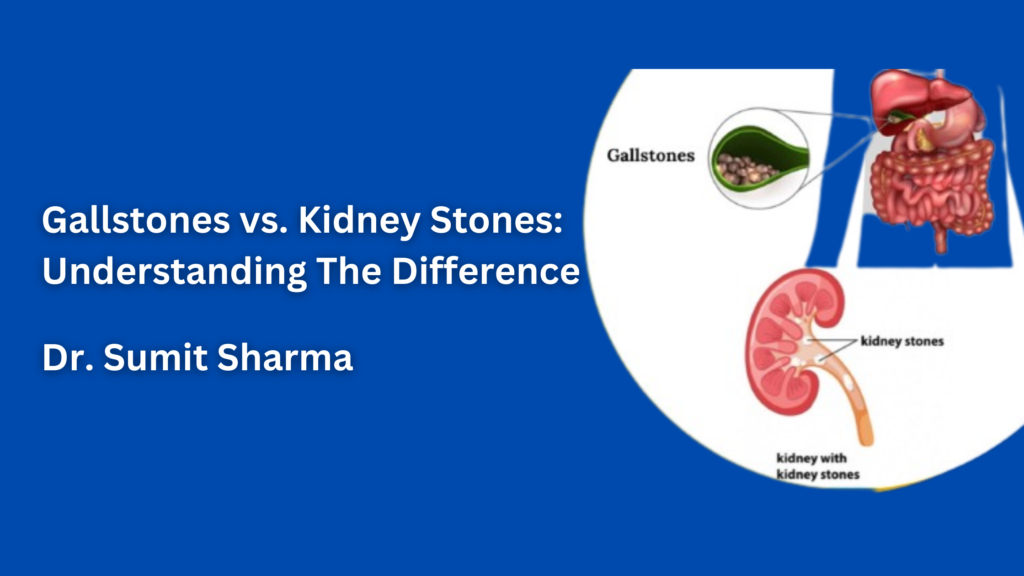
In the complex world of the human body, we sometimes face painful challenges, and two of these are gallstones and kidney stones. Although both share the ominous “stone” designation, they are entirely different in terms of their formation, location, symptoms, and treatment. In this blog, we embark on a journey to unravel the enigma surrounding gallstones and kidney stones, helping you understand not only what sets them apart but also how to differentiate them when they strike. With the knowledge provided here, you’ll be better equipped to navigate the challenges these two conditions present and make informed decisions for your health. So, let’s begin by delving into the intricate world of gallstones and kidney stones, exploring what makes them unique and how to distinguish between these two formidable foes.
Understanding Gallstones and Their Causes
Gallstones are small, solid particles that form in the gallbladder, a small organ located just beneath the liver. While they may be tiny, they can cause significant discomfort and pain when they block the flow of bile. Understanding gallstones and their causes is essential in managing this common medical condition.
The Gallbladder and Bile
Before delving into the causes of gallstones, it’s important to grasp the role of the gallbladder and bile in digestion. The gallbladder is responsible for storing bile, a digestive fluid produced by the liver. Bile is essential for breaking down fats in the small intestine. When you consume a meal rich in fats, the gallbladder contracts and releases bile into the small intestine, where it emulsifies the fats, aiding in their digestion.
Types of Gallstones
Gallstones can be categorized into two primary types: cholesterol stones and pigment stones.
Cholesterol Stones: Cholesterol stones are the most common type, accounting for about 80% of all gallstones. They form when there is an excess of cholesterol in the bile. The cholesterol in the bile can crystallize and aggregate into small, hard stones.
Pigment Stones: Pigment stones are less common and are typically associated with certain medical conditions, such as cirrhosis, hemolysis (destruction of red blood cells), and biliary tract infections. They form when bilirubin, a pigment in bile, becomes excessively concentrated and precipitates into solid particles.
Causes of Gallstones
The formation of gallstones is a complex process influenced by various factors. Here are the primary causes and risk factors associated with gallstones:
Excess Cholesterol: As mentioned earlier, one of the leading causes of gallstones is having too much cholesterol in the bile. This cholesterol can crystallize and form stones when the balance of substances in the bile is disrupted.
Slow Gallbladder Emptying: If the gallbladder does not empty efficiently or frequently enough, bile can become overly concentrated, promoting stone formation.
Excess Bilirubin: High levels of bilirubin in the bile can lead to the formation of pigment stones.
Genetics: Family history can play a role in gallstone susceptibility. If your close relatives have had gallstones, you may be at a higher risk.
Obesity: Being overweight or obese is a significant risk factor for gallstones, as it can lead to increased cholesterol levels in the bile.
Rapid Weight Loss: Losing a large amount of weight quickly, either through diet or surgery, can contribute to gallstone formation by promoting the release of extra cholesterol into the bile.
Pregnancy and Hormonal Changes: Women, particularly those who are pregnant or taking hormonal birth control, are more prone to gallstones due to hormonal changes that affect the gallbladder.
Age and Gender: Gallstones become more common with age, and women are more likely to develop them, especially during pregnancy and after menopause.
Dietary Factors: A diet high in saturated fats and low in fibre may increase the risk of gallstones.
Understanding Kidney Stones and Their Causes
Kidney stones, also known as renal calculi, are hard, crystalline structures that form within the kidneys. These tiny, yet often excruciatingly painful formations are a result of certain substances in the urine becoming highly concentrated. Understanding kidney stones and their causes is crucial for prevention and effective management.
The Role of the Kidneys
Before delving into the causes of kidney stones, it’s important to understand the vital role of the kidneys in the body. The kidneys act as the body’s natural filtration system, processing waste and excess substances from the blood to create urine. This urine is then transported to the bladder and eventually expelled from the body. When the composition of urine is imbalanced, kidney stones can develop.
Types of Kidney Stones
There are several different types of kidney stones, each with its unique composition. The most common types include:
Calcium Stones: These are the most prevalent type of kidney stones and are usually composed of calcium oxalate.
Uric Acid Stones: Uric acid stones form when there’s an excess of uric acid in the urine, often associated with conditions like gout.
Struvite Stones: Struvite stones are primarily composed of magnesium, ammonium, and phosphate. They can develop as a result of urinary tract infections.
Cystine Stones: Cystine stones are rare and are associated with a genetic disorder that causes the kidneys to excrete excessive cystine into the urine.
Causes of Kidney Stones
The formation of kidney stones is a complex process influenced by a combination of factors. Here are the primary causes and risk factors associated with kidney stones:
Dehydration: One of the most common causes of kidney stones is dehydration. When there’s inadequate fluid intake, urine becomes concentrated, increasing the likelihood of crystal formation.
Dietary Factors: A diet high in certain substances, such as calcium, oxalate, and purines, can contribute to the formation of kidney stones. Oxalate-rich foods, like spinach and beets, can lead to calcium oxalate stones.
Genetics: A family history of kidney stones can increase one’s risk of developing them.
Medical Conditions: Certain medical conditions, such as gout and urinary tract infections, can predispose individuals to kidney stone formation.
Metabolic Disorders: Conditions like hyperparathyroidism, renal tubular acidosis, and Crohn’s disease can lead to the development of kidney stones.
Obesity: Excess body weight is associated with an increased risk of kidney stones.
Geographical Factors: People living in areas with high temperatures and low humidity may be at greater risk due to increased water loss through sweat.
Medications: Certain medications, such as diuretics and antacids, can influence the composition of urine and increase the risk of stone formation.
Gallstones vs. Kidney Stones: Key Differences
Gallstones and kidney stones, both commonly referred to as “stones,” are painful medical conditions involving the formation of hard, solid particles within different parts of the body. Despite the similarity in their nomenclature, these two conditions are distinct in terms of their causes, locations, symptoms, and treatments. In this section, we will explore the key differences between gallstones and kidney stones in detail to provide a comprehensive understanding of these two distinct health issues:
1. Location
Gallstones: These solid particles form in the gallbladder, a small organ situated just below the liver. The gallbladder primarily stores and concentrates bile, which is used in the digestion of fats.
Kidney Stones: In contrast, kidney stones develop within the kidneys, the bean-shaped organs located in the lower back. The kidneys are responsible for filtering waste products and excess substances from the blood to create urine.
2. Composition
Gallstones: Gallstones can be classified into two primary types: cholesterol stones and pigment stones. Cholesterol stones are the most common, composed of excess cholesterol in the bile, while pigment stones are formed from bilirubin, a pigment in bile.
Kidney Stones: Kidney stones come in various types, including calcium stones, uric acid stones, struvite stones, and cystine stones. The most common are calcium stones, typically consisting of calcium oxalate.
3. Symptoms
Gallstones: Gallstones often remain asymptomatic until they block the bile duct. When symptoms do occur, they may include severe upper abdominal pain (gallstone attack), jaundice (yellowing of the skin and eyes), and gallbladder inflammation (cholecystitis).
Kidney Stones: Kidney stones typically present with severe pain in the back or side, which can radiate to the lower abdomen and groin. Hematuria (blood in the urine), frequent urination, nausea, and vomiting are common symptoms.
4. Diagnosis
Gallstones: The diagnosis of gallstones often involves imaging tests like ultrasound, computed tomography (CT) scans, or magnetic resonance cholangiopancreatography (MRCP).
Kidney Stones: Kidney stones are diagnosed using imaging tests like non-contrast CT scans, ultrasound, or intravenous pyelography (IVP). Urinalysis and stone analysis can also be performed to determine their composition.
5. Treatment
Gallstones: The treatment of gallstones may involve one of the following approaches:
- Watchful Waiting: If the stones are asymptomatic, they may be monitored without intervention.
- Surgery: The most common treatment for symptomatic gallstones is the surgical removal of the gallbladder, a procedure known as cholecystectomy.
- Medications: Some medications can help dissolve cholesterol gallstones in specific cases.
Kidney Stones: Treatment options for kidney stones depend on the stone’s size, composition, and location. They include:
- Pain Medications: Over-the-counter or prescription pain relievers can be used to manage the pain.
- Drinking Plenty of Water: Staying well-hydrated can help small stones pass naturally.
- Medical Procedures: For larger stones, medical procedures like lithotripsy (shock wave therapy) or ureteroscopy may be necessary to break up or remove the stones.
- Surgery: In some cases, surgical removal of stones may be required.
Dr. Sumit Sharma is the best Urologist in Gurgaon for the treatment of Gallstones and Kidney Stones.
Conclusion
Understanding these differences is not just an exercise in medical knowledge; it’s an empowering tool for better managing your health. Whether you are looking to prevent these conditions through lifestyle changes, seeking diagnosis and treatment, or simply striving to comprehend the intricacies of your own body, this understanding is invaluable.
Remember, should you ever encounter symptoms or concerns related to gallstones or kidney stones, consulting with a healthcare professional is vital for accurate diagnosis and tailored treatment. With this knowledge in hand, you can take proactive steps to minimise the risk of these painful stones and address them effectively when they arise.
Armed with the insights shared in this blog, you are better prepared to make informed choices for your health and well-being. As you journey through life, may your path be free from these rocky obstacles, and may your understanding of your body continue to grow, leading to a healthier, happier, and more informed you.
Dr. Sumit Sharma is an experienced urologist, andrologist, and kidney transplant surgeon with over 20 years of clinical experience. He is the founder of the Department of Urology at multiple hospitals in Gurgaon and has established successful kidney transplant programs across the city.
With a commitment to the highest standards, Dr. Sumit Sharma ensures personalized, professional treatment, making your well-being the primary focus. Choose Dr. Sumit Sharma for outstanding Urological care in Gurgaon.



